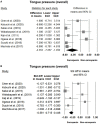Assessment of Tongue Strength in Sarcopenia and Sarcopenic Dysphagia: A Systematic Review and Meta-Analysis
- PMID: 34249993
- PMCID: PMC8264147
- DOI: 10.3389/fnut.2021.684840
Assessment of Tongue Strength in Sarcopenia and Sarcopenic Dysphagia: A Systematic Review and Meta-Analysis
Abstract
Sarcopenic dysphagia is defined as difficulty in swallowing due to sarcopenia, which may be related to weakness of the tongue muscles. This meta-analysis aimed to explore the association between tongue strength and sarcopenia and to determine whether tongue strength measurement could be a specific indicator of sarcopenic dysphagia. We conducted a systematic search of electronic databases from their inception to February 2021 for clinical studies that investigated tongue strength in participants with and without sarcopenia. The primary outcome was the weighted mean difference (WMD) and standardized mean difference (SMD) of tongue pressure between the different groups. The secondary outcome was the correlation of tongue pressure with the subcomponents that defined sarcopenia. Ten studies that involved 1,513 participants were included in the meta-analysis. Compared with those without sarcopenia, patients with sarcopenia had significantly less tongue pressure, with a WMD of -4.353 kPa (95% CI, -7.257 to -1.450) and an SMD of -0.581 (95% CI, -0.715 to -0.446). There was no significant difference in tongue pressure between patients with sarcopenic dysphagia and those with non-sarcopenic dysphagia, with a WMD of -1.262 kPa (95% CI, -8.442 to 5.918) and an SMD of -0.187 (95% CI, -1.059 to 0.686). Significant positive associations were identified between tongue pressure and grip strength and between tongue pressure and gait speed, with correlation coefficients of 0.396 (95% CI, 0.191 to 0.567) and 0.269 (95% CI, 0.015 to 0.490), respectively. Reduced tongue strength is associated with sarcopenia but is not an exclusive marker for sarcopenic dysphagia. Tongue strength correlates with the values of subcomponents that define sarcopenia. In patients with low performance of sarcopenia subcomponent, tongue pressure must be examined to diagnose subclinical dysphagia. Protocol registration: This meta-analysis was registered on INPLASY (registration number INPLASY202120060).
Keywords: dysphagia; frailty; sarcopenia; tongue pressure; tongue strength.
Copyright © 2021 Chen, Lee, Wu, Wang, Han and Chang.
Conflict of interest statement
The authors declare that the research was conducted in the absence of any commercial or financial relationships that could be construed as a potential conflict of interest.
Figures








References
-
- Cruz-Jentoft AJ, Landi F, Schneider SM, Zuniga C, Arai H, Boirie Y, et al. . Prevalence of and interventions for sarcopenia in ageing adults: a systematic review. Report of the International Sarcopenia Initiative (EWGSOP and IWGS). Age Ageing. (2014) 43:748–59. 10.1093/ageing/afu115 - DOI - PMC - PubMed
Publication types
LinkOut - more resources
Full Text Sources

